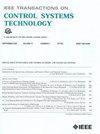Incorporating ESO into Deep Koopman Operator Modeling for Control of Autonomous Vehicles
IF 4.9
2区 计算机科学
Q1 AUTOMATION & CONTROL SYSTEMS
引用次数: 0
Abstract
Koopman operator theory is a kind of data-driven modeling approach that accurately captures the nonlinearities of mechatronic systems such as vehicles against physics-based methods. However, the infinite-dimensional Koopman operator is impossible to implement in real-world applications. To approximate the infinite-dimensional Koopman operator through collection dataset rather than manual trial and error, we adopt deep neural networks (DNNs) to extract basis functions by offline training and map the nonlinearities of vehicle planar dynamics into a linear form in the lifted space. Besides, the effects of the dimensions of basis functions on the model accuracy are explored. Furthermore, the extended state observer (ESO) is introduced to online estimate the total disturbance in the lifted space and compensate for the modeling errors and residuals of the learned deep Koopman (DK) operator while also improving its generalization. Then, the proposed model is applied to predict vehicle states within prediction horizons and later formulates the constrained finite-time optimization problem of model predictive control (MPC), i.e., ESO-DKMPC. In terms of the trajectory tracking of autonomous vehicles, the ESO-DKMPC generates the wheel steering angle to govern lateral motions based on the decoupling control structure. The various conditions under the double-lane change scenarios are built on the CarSim/Simulink co-simulation platform, and extensive comparisons are conducted with the linear MPC (LMPC) and nonlinear MPC (NMPC) informed by the physics-based model. The results indicate that the proposed ESO-DKMPC has better tracking performance and moderate efficacy both within linear and nonlinear regions.将 ESO 纳入深库普曼算子建模以控制自动驾驶汽车
库普曼算子理论是一种数据驱动的建模方法,与基于物理的方法相比,它能准确捕捉车辆等机电一体化系统的非线性特性。然而,无穷维 Koopman 算子在实际应用中无法实现。为了通过收集数据集而不是人工试错来近似无穷维 Koopman 算子,我们采用了深度神经网络(DNN),通过离线训练提取基函数,并将车辆平面动力学的非线性映射为提升空间中的线性形式。此外,我们还探讨了基函数维数对模型精度的影响。此外,还引入了扩展状态观测器(ESO)来在线估计提升空间中的总扰动,并补偿所学深度库普曼(DK)算子的建模误差和残差,同时提高其泛化能力。然后,将所提出的模型应用于预测视野内的车辆状态,并在之后提出模型预测控制(MPC)的受限有限时间优化问题,即 ESO-DKMPC。在自动驾驶车辆的轨迹跟踪方面,ESO-DKMPC 基于解耦控制结构生成车轮转向角来控制横向运动。在 CarSim/Simulink 协同仿真平台上构建了双车道变化场景下的各种条件,并与基于物理模型的线性 MPC(LMPC)和非线性 MPC(NMPC)进行了广泛的比较。结果表明,拟议的 ESO-DKMPC 在线性和非线性区域内都具有更好的跟踪性能和适中的功效。
本文章由计算机程序翻译,如有差异,请以英文原文为准。
求助全文
约1分钟内获得全文
求助全文
来源期刊

IEEE Transactions on Control Systems Technology
工程技术-工程:电子与电气
CiteScore
10.70
自引率
2.10%
发文量
218
审稿时长
6.7 months
期刊介绍:
The IEEE Transactions on Control Systems Technology publishes high quality technical papers on technological advances in control engineering. The word technology is from the Greek technologia. The modern meaning is a scientific method to achieve a practical purpose. Control Systems Technology includes all aspects of control engineering needed to implement practical control systems, from analysis and design, through simulation and hardware. A primary purpose of the IEEE Transactions on Control Systems Technology is to have an archival publication which will bridge the gap between theory and practice. Papers are published in the IEEE Transactions on Control System Technology which disclose significant new knowledge, exploratory developments, or practical applications in all aspects of technology needed to implement control systems, from analysis and design through simulation, and hardware.
 求助内容:
求助内容: 应助结果提醒方式:
应助结果提醒方式:


